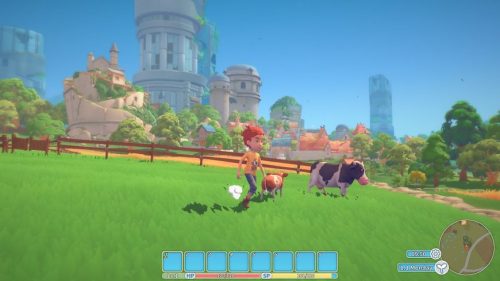By Adele Chapline Smith | Catholic News Service
NEW YORK (CNS) — “My Time at Portia” (Team17) provides a fresh and, in some respects, unusually upbeat take on the tried-and-true post-apocalyptic genre. This imaginative and colorful role-playing game (RPG) is suitable for all but the youngest players.
Long after the collapse of a previous civilization, humanity has re-emerged from its underground hiding places to begin life anew on the Earth’s surface.
In this context, gamers take up the hammer of a young builder who can be either male or female. Having inherited a workshop in the town of Portia from his or her father, the controlled character moves there, repairs the establishment and commences business.

As in Chucklefish’s “Stardew Valley” and similar games, the primary focus here is twofold: construction and the gathering of resources such as stone, wood and seeds. The player’s ability to collect animal feces for crop fertilization introduces a touch of earthy humor as well as realism.
More significantly, gamers can customize their chosen persona, always a welcome option that helps to form a deeper connection to the fictional realm within which they will be operating. The world of “Portia” also features a day-night cycle and seasonal mechanics integral to agriculture.
Local villagers ascribe to a religion called the Church of Light, which preaches harmony but opposes any effort to recover the advanced technology of an earlier era. Underlying this stance is the fear that any such rediscovery would only lead to a repetition of the wars that brought the world to its knees before.
Those who work at a facility called the Research Center, by contrast, believe the past holds the key to future progress. Neither group is portrayed as evil since both are working to achieve the same goal of health and happiness for the townspeople. Yet the parents of impressionable players may be concerned that the narrative hints at a real-life conflict between faith and science.
Some of the female inhabitants of Portia, moreover, sport revealing blouses. Though their behavior is not sexualized, this costuming seems out of place in a title aimed at a wide range of age groups.
The builder can engage in friendly sparring matches with other human characters, but this combat is neither bloody nor fatal. Battling monsters is a more serious business and involves the use of axes, dart guns or flamethrowers. Yet, although they’re accompanied by light effects and impact sounds, even these conflicts are far from graphic.
With gameplay running to about 80 hours, many warm, enjoyable experiences await visitors to Portia. But the few mildly problematic elements listed below suggest that tourism there is most appropriate for teens and grown-ups rather than little ones.
Playable on PlayStation 4, Xbox One, Nintendo Switch and PC.
The game contains non-scriptural religious themes, cartoonish violence, occasional images of somewhat immodest clothing and some crude humor. The Catholic News Service classification is A-II — adults and adolescents. The Entertainment Software Rating Board rating is E — everyone.
Smith reviews video games for Catholic News Service.






















